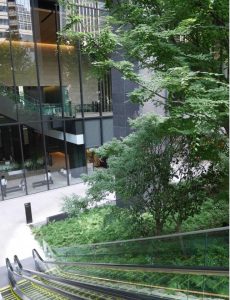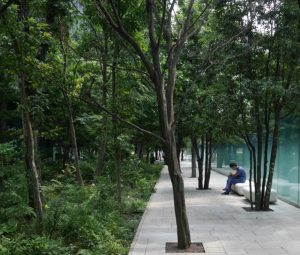Keynote speaker at the IUFRO Regional Congress for Asia and Oceania – Forests for Sustainable Development: The Role of Research
The Role of Forests in Urban Green Spaces

Professor Makoto Yokohari, Graduate School of Engineering, The University of Tokyo, Japan
Professor Yokohari, landscape and urban planning, urban ecology, and ecological landscape design are at the core of your academic interests. The IUFRO Regional Congress for Asia and Oceania draws attention to the particular role that forests play for the sustainable development in urban and peri-urban areas and has identified “Urban forestry for human health and community well-being” as one of its key themes.
Q: Urban green spaces have significantly gained in importance worldwide in view of rapid urbanization of society and the development of megacities. What are the major benefits of urban green spaces in general?
A: Three clusters of ecological functions, or benefits, can be listed, which are “human comfort”, “conservation of physical environment” and “conservation of biological environment”. The first cluster includes functions as landscape conservation and recreational uses, the second includes microclimate control and water retention, and the third includes conservation of ecosystems and biodiversity.
Q: What do you consider to be the most important components of urban green space planning? Is there, in your opinion, a common error that is made in terms of urban green space planning?
A: Urban green spaces are different from pristine nature in deep mountains or on isolated islands. They are always under, both positive and negative, human impacts. Instead of being a fundamentalist who takes pristine nature as an exclusive reference, we have to be adaptive and discuss various alternative goals which may balance the three clusters of ecological functions mentioned above.
How do forests as part of these green spaces contribute to the well-being of people in the city?
A: No matter which cluster of ecological functions you are concerned, forests play the key role in urban green spaces. However, once again, we have to be adaptive to accept various alternative goals. In contemporary cities not native but horticultural and introduced species may sometimes fit better to the environment and thus provide better solutions.
 Q: Do you have any examples of measurable physiological or psychological health benefits from forests and trees in cities?
Q: Do you have any examples of measurable physiological or psychological health benefits from forests and trees in cities?
A: My research group is now studying how urban greens may reduce heat damages on athletes on hot summer days, but we haven’t reached the conclusion yet. We shall be able to report the outcome of the study at the next IUFRO conference, if IUFRO gives us a chance!
Q: Are there also economic benefits from urban trees and forests? If so, can you please elaborate on those benefits?
A: Contributing to the restoration of urban greens, including forests, is regarded as one of indispensable CSR (Corporate Social Responsibility) activities by major enterprises having their headquarters in downtown Tokyo. Responding to such a movement key developers who own real estates in the CBD (Central Business District) of Tokyo are now keen to restore forests at the foot of their sky scrapers as it will eventually be reflected to higher rental prices of their properties.
Q: Trees can also become a risk in densely populated areas, especially in the case of disastrous weather events such as storms and heavy snowfall. When you plan urban environments, how do you take this potential risk into account?
A: I believe this is a question of B/C; the balance between cost and benefit. High returns are always associated with high risks. Providing general public not only enough information both on benefits and risks of having trees in their neighborhood but teaching them how to minimize the risk may be the key.
Q: Asia is home to more megacities than any other continent. Can you briefly define the term “megacity” and explain what the main challenges for these cities are?
A: I understand that Asian megacities are massive aggregations of oversized towns and villages, as they often maintain “rural” characters both in physical and social perspectives without having a core in the center. So many challenges on housing, transportation, resource and energy management, and sanitary condition may be nominated, but above all we have to make the cities smaller to provide substantial solution as the challenges may be identified not only in cities themselves but in rural areas as cities are absorbing people from rural areas resulting in depopulation and decline of agriculture and forestry in rural areas.
Q: You work as a consultant for the National Capital Region Planning Committee of the Japanese Government and The Urban Agriculture Plan of The Tokyo Metropolitan Area. Tokyo is known as a successful and functioning megacity. What can other cities learn from Tokyo?
A: There are so many ways to discuss this issue and I need pages to fully express my thoughts, but perceiving from my profession maintaining a certain order in land use, not only in tangible and intended manner but in intangible and unintended manner, should be nominated as one of reasons of the success. Perceiving from European and American perspectives land uses in Tokyo Metropolitan Area may look chaotic and disordered, but in fact there are “hidden” orders respected and shared by the public.
 Q: Tokyo will host the Olympic Summer Games 2020 and you are an official technical advisor for this project. How will urban planning and development for this event integrate trees and green spaces and what positive effects do you expect for people and the environment?
Q: Tokyo will host the Olympic Summer Games 2020 and you are an official technical advisor for this project. How will urban planning and development for this event integrate trees and green spaces and what positive effects do you expect for people and the environment?
A: 2020 Olympic Games will be held from late July to early August, which is the hottest time in Tokyo with over 30C heat and 80% humidity. Holding outdoor games including marathon will be crucial not only for athletes but for spectators if we do not take proper measures to reduce their heat impact. Urban greens including trees play significant roles in making athletes and spectators comfortable on boiling summer days, and thus creating a network of greens in downtown Tokyo should be regarded as one of legacies of the Olympic Games.
Q: What is your personal vision of life in a modern city in which you would like to live yourself?
A: We should not forget that cities, no matter where on the globe they are located, used to be an entity where you may receive good wages but sacrifice your health. The situation has improved but it is still the way you should understand cities in the world today. You have to decide which benefit is indispensable for your life, as you can’t get both. Myself? I’m still too young to give up my business but getting too old to sacrifice my health. I have to make a decision before it becomes too late.
Thank you very much.
Photo credit Picture 2 and 3: M Yokohari

Leave a Reply